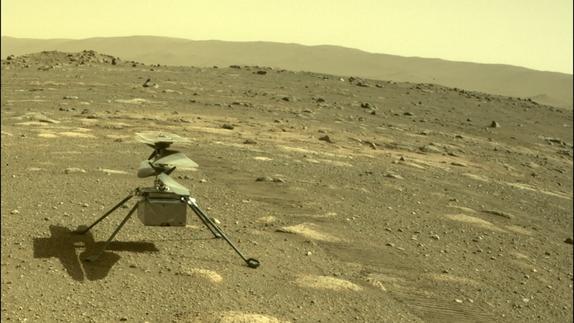 This NASA photo obtained on April 6, 2021, shows Ingenuity helicopter seen on Mars as viewed by the Perseverance rover’s rear Hazard Camera on April 4, 2021. (HANDOUT / NASA / JPL-CALTECH / AFP)
This NASA photo obtained on April 6, 2021, shows Ingenuity helicopter seen on Mars as viewed by the Perseverance rover’s rear Hazard Camera on April 4, 2021. (HANDOUT / NASA / JPL-CALTECH / AFP)
LOS ANGELES - The Perseverance Mars rover of the US National Aeronautics and Space Administration placed a rock sample on the surface of Mars on Wednesday, marking a historic early step in NASA's Mars Sample Return campaign.
The sample was put in a titanium tube. Over the next two months, the rover will deposit a total of 10 tubes at the location, building humanity's first sample depot on another planet, said NASA.
Based on the architecture of the Mars Sample Return campaign, the rover would deliver samples to a future robotic lander. The lander would, in turn, use a robotic arm to place the samples in a containment capsule aboard a small rocket that would blast off to Mars orbit
Based on the architecture of the Mars Sample Return campaign, the rover would deliver samples to a future robotic lander. The lander would, in turn, use a robotic arm to place the samples in a containment capsule aboard a small rocket that would blast off to Mars orbit, where another spacecraft would capture the sample container and return it safely to Earth, according to NASA.
ALSO READ: NASA's Orion capsule returns to Earth after moon mission
The depot will serve as a backup if the rover cannot deliver its samples. In that case, a pair of Sample Recovery Helicopters would be called upon to finish the job, said NASA.
The Perseverance rover was launched from Florida in July 30 of 2020, and touched down safely on Mars in February 2021. It is the first rover to bring a sample caching system to Mars that will package promising samples for return to Earth by a future mission.
READ MORE: Challenges await sample-return expedition to Mars
A key objective for Perseverance's mission on Mars is astrobiology, including the search for signs of ancient microbial life.


